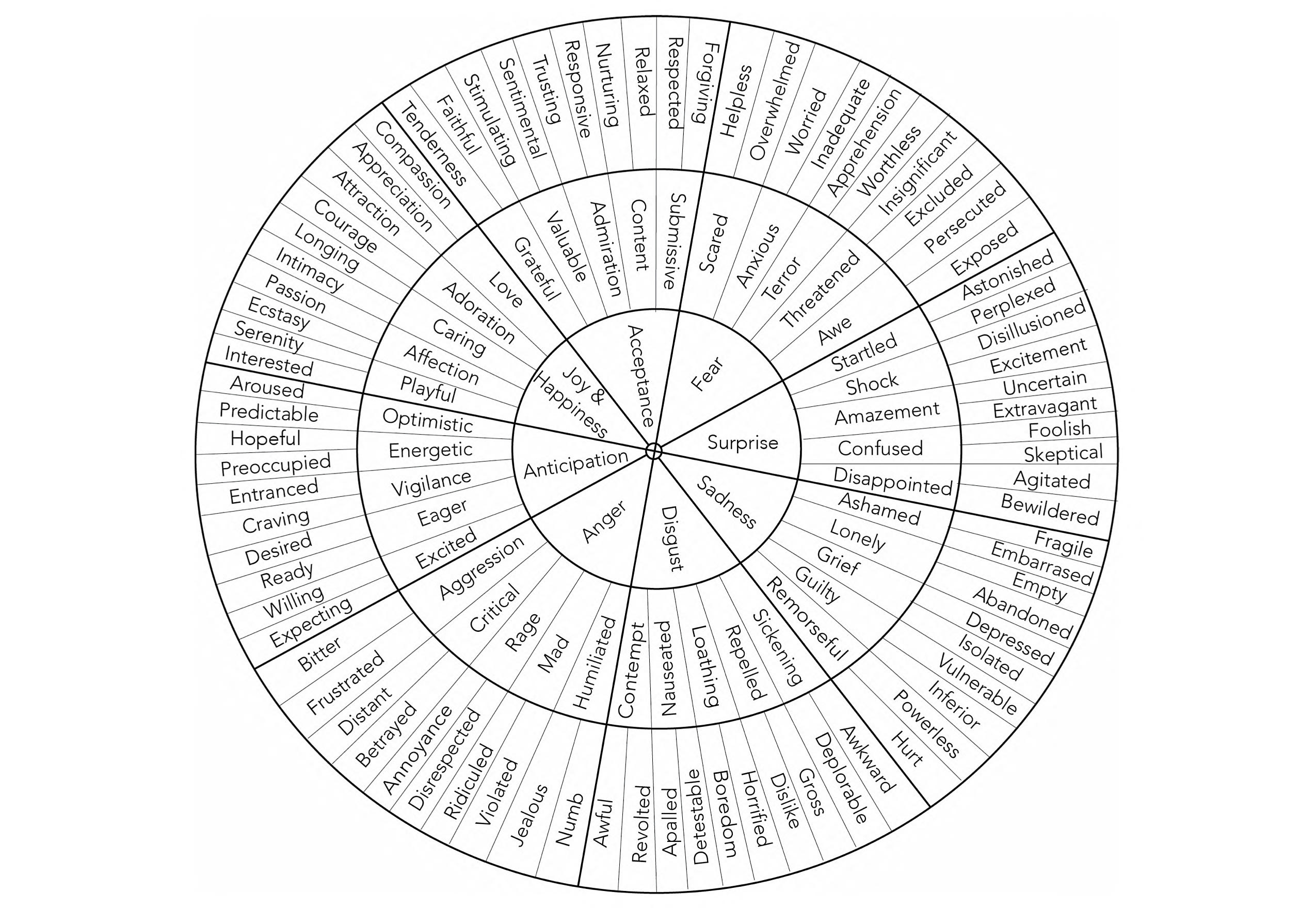7 Steps to Manage Difficult Emotions

“Negative thoughts, emotions, and beliefs are said to be like Velcro; they stick easier than their positive counterparts,” says Rebecca Acabchuk, Ph.D., a neuroscientist and senior researcher at Roundglass. While it’s normal to have a negativity bias, getting stuck on it can lead to unnecessary suffering because you may create more of what you don’t want to experience.
According to David Vago, Ph.D., Roundglass research lead and neuroscientist, some recent scientific reviews suggest focusing on depressive thoughts and negative emotions, like anger and fear, can increase the wear and tear on your body, therefore accelerate aging.
“The evidence even supports that if these types of thoughts and emotions are not properly managed, they can lead to pervasive inflammation contributing significantly to neurodegenerative disorders like Alzheimer’s and Parkinson’s disease,” he says. Over time, persistent negative thoughts and emotions can weaken your immune response, making you more susceptible to developing diseases.
This doesn’t mean you should suppress negative feelings either, as research suggests that ignoring them can harm your physical health. It might seem counterintuitive but facing your emotions can support you in processing them.
Use Emotional Awareness to Manage Difficult Emotions
Being emotionally aware means you notice your feelings, name them, and allow yourself to experience their rise and fall. It’s a balance between releasing the need to control their intensity and not letting them consume you.
Connecting to your breath while witnessing your feelings can support you in learning about your triggers. It’s also a great way to learn that emotions aren’t permanent.
Pro Tip: “You can recognize their [emotions] impermanence while learning what may have caused them to arise,” says Kasandra Jewall, a Roundglass yoga teacher.
Use Emotional Awareness to See the Temporary Nature of Emotions
When you allow yourself to be emotionally aware, you learn to recognize emotions for what they are — simple sensory experiences passing through your awareness.
You can think of this awareness like an emotional digestive system. But, instead of breaking down the foods you eat and absorbing their nutrients into your cells and bloodstream, you're absorbing and processing your experiences.
It can be hard to control the things or people who might trigger your emotions, but channeling that energy into digesting these experiences makes managing difficult emotions that much easier. “Your ability to understand yourself and why you feel the way you feel will give you a more grounded space to react from,” Jewall says.
Here are 7 mindfulness-infused tips that can support you as you learn to digest difficult emotions.
Managing Difficult Emotions: A Mindful Practice
1. Invite In What Is
Dr. Acabchuk suggests rather than viewing emotions as good or bad, try allowing yourself to become curious about how you feel, without any judgment toward the feelings themselves.
Pro Tip: “Ask yourself, ‘How am I feeling today?’ and welcome all that arises, with an honest, open heart,” Dr. Acabchuk says.
2. Recognize and Name Your Feeling(s)
Naming your feeling can help you step back and look at it from a distance. This separation creates space for you to calm your body and settle your mind.
This labeling practice has other benefits, too. “Increased emotion identification is related to higher levels of perceived control, fewer negative thoughts, and healthier relationships,” Dr. Vago says.

Pro Tip: The Roundglass Feelings Wheel can help you label your emotions more specifically, leading to greater insight. At the center of the wheel are seven primary emotions and the two larger circles include a variety of feelings. "Emotions are the automatic responses that appear before certain stimuli, such as the sadness we experience when we lose a loved one," Dr. Acabchuk says. "Feelings are the subjective perceptions of emotions, the way each of us interprets the emotion and gives it a name."
3. Accept the Emotion as Part of Your Present Experience
Trying to push difficult feelings away doesn’t make them disappear. Buried emotions can leak out at times, especially under stress, causing you to act in ways that you might regret later.
This could look like speaking to colleagues in a short manner or raising your voice to your kids when you don’t mean to. Use meditation to accept the existence of difficult emotions, which allows you to experience and then release them.
4. Assure Yourself the Emotion Is a Phase
“My silent retreat meditation practice helped me understand that every emotion has a beginning, a middle, and an end,” says Grace Edmunds, a Roundglass meditation teacher.
Recognizing the impermanence of your emotions can help you witness them without feeling overwhelmed or personalizing them. Reminding yourself, “this too shall pass,” can provide strength to endure challenging times.
Try this mini-course, Lift a Low Mood, by Dr. David Vago and Almeiri Santos to learn how to embrace your emotions in the moment.
5. Understand the Emotion
When you know what you feel, you can learn why you feel, and knowing this may help you better process the experience. Toni Parker, Ph.D., a certified Gottman therapist, suggests asking yourself questions like, “what triggered me?” Or “why do I feel this way?” after you’ve calmed down.
“Asking yourself these critical questions and investigating the root of your difficult emotions will help you gain empathy and insight into what you are experiencing,” she writes.
Try this class, Embrace Your Emotions, by Greta Hill, a Roundglass meditation teacher, to learn how to objectively experience your emotions so you can understand them.
6. Let Go of the Need to Control Your Emotional State
It’s normal to want to control your emotions, especially when they seem overwhelming. However, Jewall recommends doing something active the next time you feel the need to suppress those intense feelings. Moving your body can support you in processing what she calls “emotional energy.”
“I would encourage people to do meditation or something active like yoga to help them move emotional energy,” she says. If you can’t move your body, Jewall recommends drawing. “Even taking a piece of paper and scribbling may bring insight,” she adds.
One study found that young, middle-aged, and older adults who engaged in high and moderate levels of exercise had higher life satisfaction than the participants who engaged in low levels of exercise. This means they were more likely to experience positive emotions when they thought about the unique circumstances of their lives. Positive thinking and positive emotions can make it easier to experience and recover from stress.
7. Identify and Embrace Emotional Suffering
Pain is universal; something we all sense, yet we often feel alone in times of distress.
Reminding yourself that everyone experiences pain, and that suffering is part of the human condition can bring comfort during times of adversity. And Metta or loving-kindness meditations can help you nurture this knowledge. One part of the practice asks you to recognize shared humanity by telling yourself, “I’m not the only one suffering in this way.”
Taking this broader view can shift your attention away from yourself, to help avoid developing a victim mindset. “By reprogramming the way, we think, and what we focus our attention on, we can transform the way we feel and how we live our lives,” Dr. Vago says.
Learning to manage difficult emotions takes repetition and focus. But honouring the existence of challenging feelings can help you find unique ways to process them. In addition to the 7 mindful coping strategies, a complementary practice includes finding the positive.
Practicing positive thinking can make a big difference when it comes to managing emotional workloads.
Use These 7 Steps to Practice Positive Thinking
Humans have an ingrained negativity bias because it helps to protect us from harm, “remember the threat, to help you remain safe,” Dr. Acabchuk says. It’s why you tend to recall, then focus on, one piece of negative feedback in a presentation that went well.
However, it’s important to practice positive thinking because it can increase resilience to stress. “Some stressors are unavoidable, but we do have some power over how our thoughts and emotions contribute to our mental and physical health.” Dr. Vago says.
Instead of focusing on feeling anxious about being late while sitting in a traffic jam, use mindfulness to notice that you’re anxious. Then practice positive thinking by being grateful for having a car or getting some extra time to listen to music.
Simply being aware of what you tell yourself can help you pause and choose to find the positive.
Pro Tip: “Gratitude, compassion, awe, and curiosity are all techniques that strengthen positive thinking,” Dr. Acabchuck says.
While everyone’s emotional experience is unique, infusing mindfulness as you practice positive thinking can support you in feeling and healing whatever difficult emotion you're facing. Here are some examples.
Soothe Sadness
With social stereotypes and gender norms, sadness might be one of the most difficult emotions to express. But to soothe sadness, you'll have to feel it. This could look like bellowing into a pillow, replaying your favorite Adele album, or simply sitting and being with your sadness. However, you choose to express it, remember that sadness is just an emotion, and it will, like all emotions, pass.
Sadness is different from depression because of its temporary nature. Depression can happen when you've lost interest in all the things that used to bring you joy. You may also find you spend more time alone, not because it's rejuvenating, but because you feel isolated.
Pro Tip: If you're experiencing depression, try seeking professional help, as it's considered a "mental illness and should be treated seriously," Dr. Vago says.
Unpack Shame
Many people may use guilt and shame interchangeably, but shame researcher Brené Brown separates the two. Shame focuses on the self, and guilt focuses on the action. You can think of shame as saying, "I am embarrassing," versus guilt; "I did something embarrassing." While both feelings are harmful, shame can be more dangerous because "it can chip away at our self-worth," Dr. Vago says.
Outside of meditation, Dr. Vago recommends finding a safe environment where you can openly talk about your feelings of shame. “If there was shame for a specific behavior, it would be typical to speak to a psychologist or supportive group therapy to unpack the shame and associated clinical symptoms,” he says. This is because shame is usually tied to having some secret, and letting it out can help you understand and release it.
Pro Tip: "Seeking out a supportive environment to discuss feelings of shame can help them dissipate," Dr. Vago says.
Dial Down Fear
"Being scared and experiencing fear are two of the same expressions of one of the most primal universal emotions," Dr. Acabchuk says. Fear also varies in intensity; you may experience nervousness or uneasiness on the low end, and panic or horror if you're very scared.
Fear isn't always bad because it can help prepare you for potential threats. It can, however, become destabilizing if the threat is perceived as overwhelming. "We may experience helplessness, further anxiety, and thoughts that prolong the stress response," Dr. Vago says.
This can also lead to developing a phobia — a persistent irrational fear.
To dial down fear, try to calm your nervous system through deep breathing. Remind yourself that it’s just your body trying to protect itself, and this feeling will pass.
Pro Tip: If you're dealing with a phobia, seek mindfulness-informed, exposure therapy from a trained individual. "Learning how to breathe through the waves of emotion can support dealing with phobias," Dr. Acabchuk says.
Defuse Anger
Analytical anger meditations can help you understand and calm your anger. The practice invites you to consider a series of questions that include, “how is this anger affecting other people and me?” Or “where am I holding that anger in my body?”
Answering these questions may help you recognize your triggers. Knowing this can support you in setting a specific remedy for each.
It can be dangerous to suppress anger, but it also shouldn't be let out by reacting to your trigger at that moment. This is because you're likely teaching your brain to habituate a pattern of exploding when angry.
Whenever you feel enraged, ground down to your breath as you remember that antidote you've set for yourself during meditation. Whether taking a walk, splashing cold water on your face, or simply connecting to the pause between each breath, allow yourself to feel the anger so you can mindfully respond and release it.
Pro Tip: Practice the analytical anger meditations when you're calm for greater insight into your triggers and more clarity to develop antidotes.
Cope with Grief and Loss
You might be mourning the loss of a loved one or drastic changes in your relationship(s), health, or life. The uncertainty, rage, and despair that come with that may sometimes feel as if you want to implode. But connecting with other people who are suffering in the same way may help.
In one study, caregivers experiencing grief for the death of cancer patients they nursed found sharing their stories of suffering helped to make them feel less alone and less stressed. They also found it easier to make sense of their situations.
Dr. Vago recommends grief counseling if you find you are struggling to recover from the loss of a loved one. It may offer a more personalized approach in helping you cope with the intensity of your emotions, which you can use long after you decide to stop going.
Pro Tip: If you're interested in seeing a grief counselor, try going to one that includes body scans or other mindfulness meditation practices, as they may "help to restore a sense of ease in the body," Dr. Vago says.
Learn to Ride the Waves of Your Emotions
When you think of difficult emotions, Jewall suggests imagining your mind as a ship drifting through them. Like waves, they come and go; like waves, they can wreck you. But you can always use emotional awareness as a sail to “catch and harnesses mindful practices” that can help you identify, experience, and better manage your difficult emotions.
Try this class, Working Through Difficult Emotions, by Palma Michel, a Roundglass mindfulness coach, to learn how to befriend and transform any difficult emotion.
Key Takeaways:
- Learn to recognize emotions through awareness.
- Mindful movement can help in releasing control of an emotion.
- Practice positive thinking to combat negativity.




